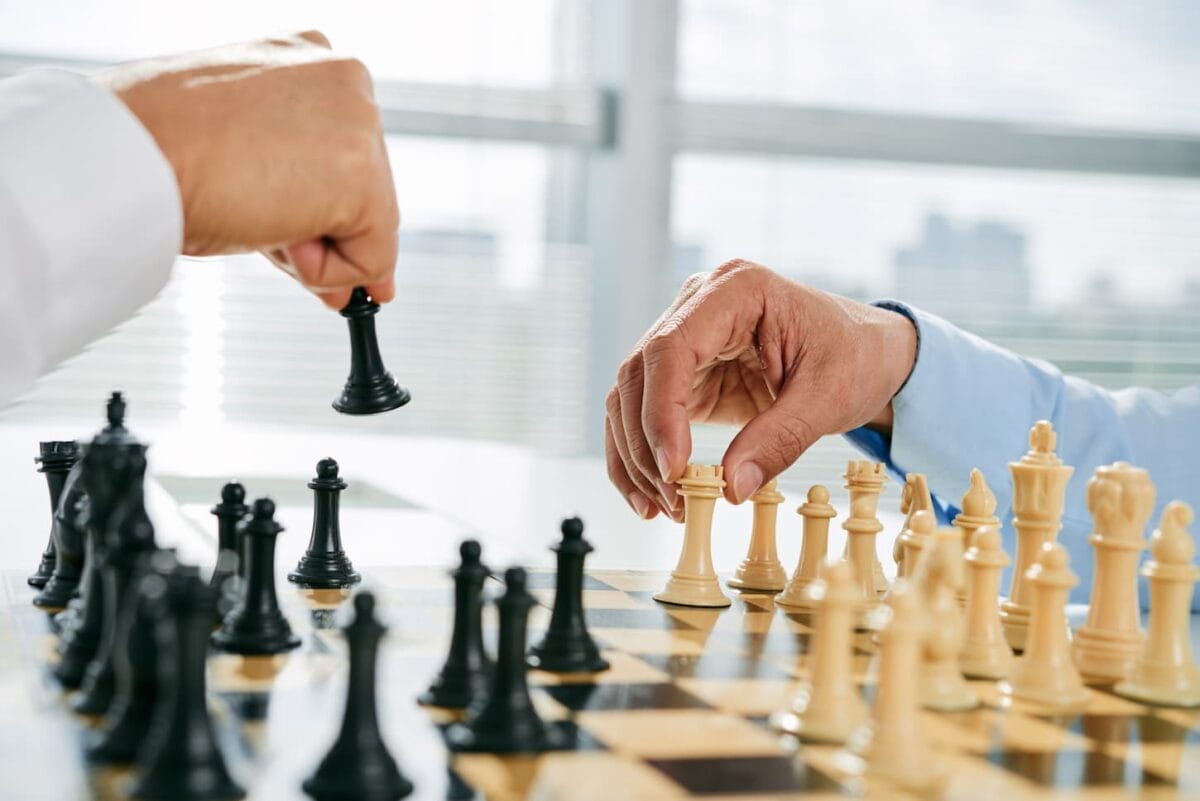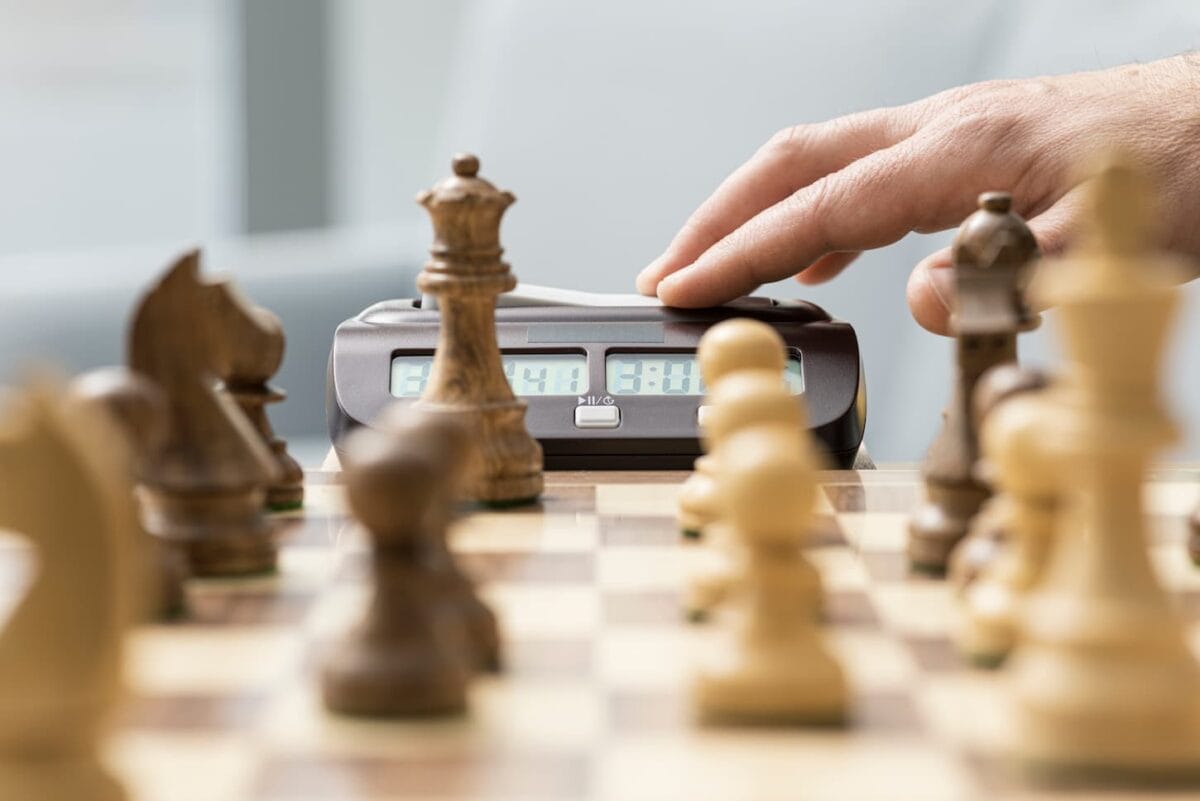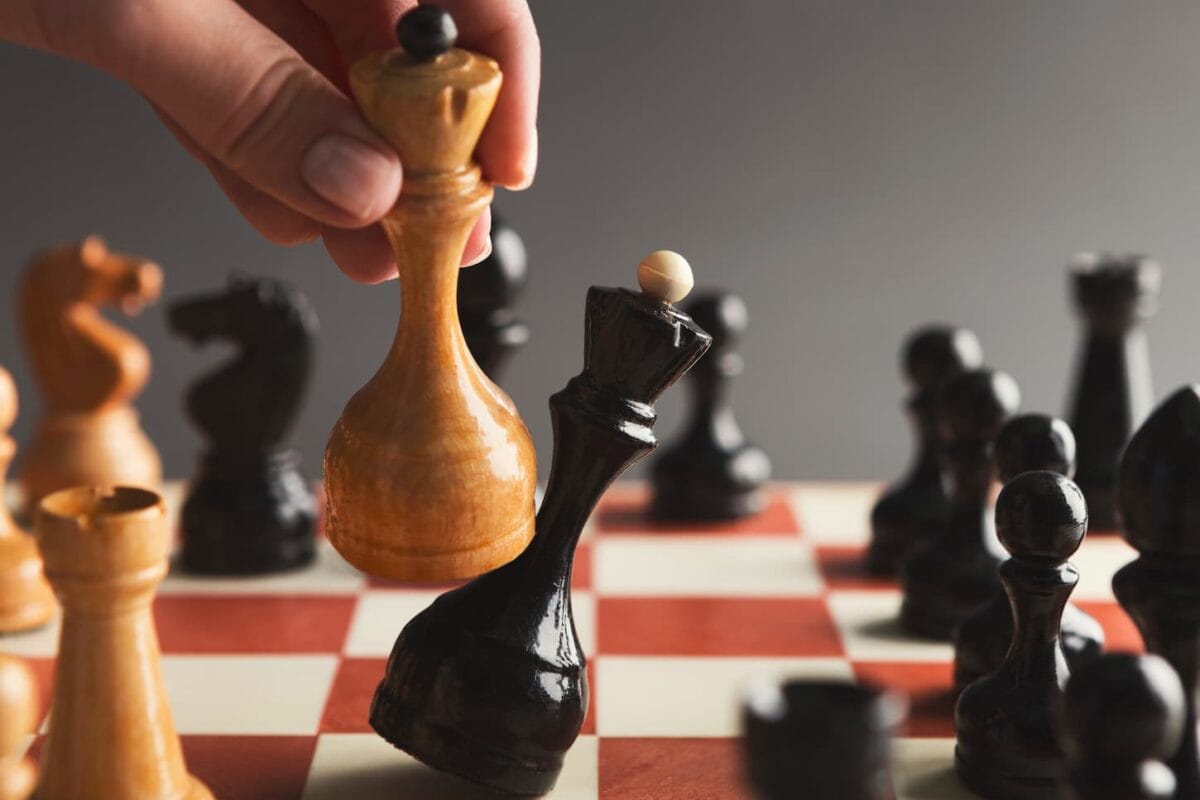Learning chess can be both exciting and rewarding. As a strategic board game with a rich history spanning over a thousand years, chess can provide you with endless hours of mental stimulation and enjoyment. Understanding the various intricacies of this game may seem daunting, but I promise it’s doable.
The key to learning chess is to start simple. Start by learning each piece’s basic rules and distinct movements. Then you can learn more advanced moves and common playing strategies. Afterward, you can focus on advanced strategies and learn to see potential moves and checkmates.
Various resources are available to help you learn chess, whether you want to be a chess master or want to learn a new game with a rich history. So, dive in, and immerse yourself in the fascinating chess world. Let’s get started!

Basics of Chess
While chess can seem complicated and has a rich history and strategies, it is built on simple rules and piece movements. Chess has a single objective: to take the other team’s king.
Rules and Objectives
In chess, you play against a partner. You control the white or black pieces, and your opponent takes the other color. The objective is to capture your opponent’s king by trapping it so it cannot escape your attacking pieces. The game can end with a checkmate or a draw (under certain conditions).
Each type of piece moves uniquely on the board. The main aspects of the game include:
- Moving pieces according to the pieces’ unique rules.
- Special rules like castling, en passant, and pawn promotion.
- Understanding check and checkmate.
Chess Board and Pieces
The chess board consists of 64 alternating checkered squares with 8 rows called ranks and 8 columns called files. Each player begins with a set of 16 pieces, including:
- 1 King
- 1 Queen
- 2 Rooks
- 2 Bishops
- 2 Knights
- 8 Pawns
These pieces possess unique movements and abilities.
- The King moves one square in any direction.
- The Queen moves in any direction for any number of squares.
- The Rook moves vertically or horizontally for any number of squares.
- The Bishop moves diagonally for any number of squares.
- The Knight moves in an L-shape, consisting of two squares in one direction and one square in the perpendicular direction.
- The Pawn moves forward one square but captures diagonally.
Set Up and Starting Colors
When setting up the chessboard, each piece has a set starting place.
- Place the rooks in the corners, then the knights beside them, followed by the bishops.
- The queen should be placed on her matching color square, with the king by her side.
- Finally, the pawns are placed in front of these pieces.
In a standard chess game, the player with the white pieces gets to move first. After that, players take turns moving their pieces according to the rules.
Moves and Special Rules
Movement of Each Piece
- Pawns: Pawns move one square forward but capture diagonally. On their first move, they can advance two squares forward.
- Knights: Knights move in an L-shape, either two squares forward and one square sideways or one square forward and two squares sideways. They are the only piece that can jump over other pieces.
- Bishops: Bishops move diagonally across the board. They are limited to moving on squares of their starting color.
- Rooks: Rooks move horizontally or vertically any number of squares. They play a key role in the specialty move called “Castling.”
- Queens: Queens can move any number of squares horizontally, vertically, or diagonally. They can’t change directions once they start moving. They are the most powerful piece on the board, although taking (or losing) a Queen doesn’t end the game.
- Kings: Kings can move one square in any direction. Kings can be “Castled” to avoid checkmates. They are the most important piece on the board to protect, as losing the king means losing the game.
En Passant
En passant is a special pawn capture. When a pawn on its starting line moves two squares forward from its starting position and lands beside an opponent’s pawn, the opponent can capture the pawn “en passant” (as if it moved only one square forward) on the next turn. This capture must be made on the next move, or the right is lost.
Think of it this way: if you’ve kept your pawns in reserve for a while, and now that your opponent is getting close, you want to move your pawns so they don’t get captured? You can still lose them to the en passant move.
Castling
Castling is a special move involving the king and one of the rooks. It is performed when neither the king nor the chosen rook has moved previously, but there are no pieces between them (the bishop and knights have been moved).
The king moves two squares toward the rook, and the rook moves to the square next to the king. Castling helps protect the king and activate the rook for future moves.
Promotion
Promotion occurs when a pawn reaches the opposite side of the board (8th rank for white, 1st rank for black).
The pawn can be promoted to any other piece except for a king.
This rule allows players to gain an advantage by reaching the promotion zone.

Strategies and Tactics
Chess goes from a basic game of moving pieces (with specific movements) to a history-rich game of strategy once you start using tactics like opening moves, middle-game strategies, and end-game options.
Openings
The opening phase of a chess game is crucial for setting up strong positions and controlling the center.
Familiarize yourself with classic openings like the Ruy-Lopez and the Sicilian Defense. Make your first move with a pawn in the center to control key squares and allow your knight and bishop to develop.
Some popular openings include:
- Ruy-Lopez
- Sicilian Defense
- French Defense
- Indian Defense
Middlegame
In the middlegame, you should focus on setting up tactics and executing strategies to gain an advantage. Some key strategies to consider include:
- King safety: Ensure your king is safe through castling and protecting surrounding pieces.
- Piece coordination: Strategically place your pieces to create threats and potential combinations.
- Forking: Utilize Knight forks to remove two opposing pieces in one move.
- Control the center: Maintain control of the center squares, as this is where most of the action occurs.
Endgame
As the game progresses toward the endgame, fewer pieces are on the board, and your strategy should adapt accordingly. Your focus should now be on:
- King activity: Use your king more actively to support your remaining pieces, as it is less susceptible to threats in this stage.
- Pawn structure: Ensure your pawns maintain a strong formation to support your pieces and to create potential promotion opportunities.
- Promotion: Gradually advance your pawns to the other side of the board and promote them into more powerful pieces, such as queens.
- Zugzwang: Force your opponent into a situation where any move they make would worsen their position.
By understanding these strategies and tactics, you’ll be better prepared for different situations in chess games. Make sure you practice these concepts regularly, as this will increase your chances of winning and improve your ability to withstand various attacks.
Chess is a game of skill, so continual practice and analysis are key to your success.

Check, Block, and Checkmate
When playing chess, players must know and understand what the differences are between a check, a block, and a checkmate, as these can make or break a game.
Check
When playing chess, understanding the concept of a check is crucial.
A check occurs when an opponent’s piece directly threatens your king, and you must take one of three actions to protect it.
- Move the king.
- Block the check with another piece.
- Capture the checking piece.
By familiarizing yourself with these methods, you can improve your defensive skills and protect your king.
Block
Blocking a check is an essential technique to master in your chess journey. When one of your pieces checks your opponent’s king, they may block the threat by placing another piece between their king and your attacking piece.
As a player, you should also be aware of this strategy when your king is in check.
Look for opportunities to intercept the attacking piece by moving one of your other pieces into its path. This can save your king from danger and help maintain the balance of power on the board.
Checkmate
Ultimately, the goal of chess is to achieve checkmate.
Checkmate occurs when your opponent’s king is in check, cannot move to a safe square, and nothing can capture the attacking piece. The game ends immediately, regardless of how many pieces are left on the board.
Learning various fastest checkmate scenarios can help you recognize patterns and seize victory when opportunities arise.
Practice recognizing these scenarios during games and training sessions, and you’ll find yourself delivering checkmate more effectively over time.
Learning Resources
When learning to play chess, there are various learning resources that players ought to utilize, whether they simply want to learn the game to play for fun or if they want to become a chess master.
This site uses paid referral links from carefully selected advertising partners. I only promote products I like, use, and recommend. As an Amazon Associate, I can earn from qualifying purchases. Please refer to my disclaimer in the terms and conditions for additional details.
Learn to Play the Basics
One of our family’s favorite learning resources for chess is a learn-to-play version game called “No-Stress Chess.”
It’s chess, but with cards to help you familiarize yourself with the moves while teaching you some basic strategies.
It’s been a staple game in our household, and we’ve used it to teach other kids in our neighborhood how to play chess. If you’re starting out with chess, it’s a must-have game to keep in your closet.

Online Courses
To learn how to play chess and improve your skills, various online courses are available for all levels.
Platforms like Chess.com and lichess.org offer interactive and fun ways to study chess. These resources ensure that learning chess is easier for you while engaging and enjoyable.
Chess Lessons
Chess lessons can greatly help you develop a strong foundation in the game.
Chess lessons may be taught in person or online. If you don’t know of a local chess club with a reputable chess master, you may want to look for online options.
Many online platforms provide you access to chess lessons where you can learn from masters and experienced players, or you can find in-person lessons.
Websites like Chess.com offer various lessons, allowing you to practice positions, endgames, and openings – and review your games.
Chess Puzzles
Puzzles are essential to learning chess, as they help you sharpen your tactical skills and improve your problem-solving abilities.
Platforms like lichess.org provide a wide range of chess puzzles, from simple tactics to complex combinations. Solving puzzles regularly is a great way to enhance your chess abilities.
Famous Games
Analyzing famous chess games can be an effective way to learn and appreciate the art of chess. By studying the moves and strategies used by grandmasters, you can gain insights into their thought processes and decision-making.
Websites like Chess.com offer a vast catalog of famous games, allowing you to learn from the best players in the game’s history.
Key Takeaways
Playing chess can be both an enjoyable and rewarding experience. By learning the game’s rules and practicing chess strategies, you will gradually improve your skills and confidence.
While it may seem daunting initially, remember that chess can be as easy or challenging as you make it.
To get started, focus on the basic principles, such as controlling the center of the board, developing your pieces efficiently, and protecting your king. As you progress, you can delve into more advanced concepts and strategies.
One significant benefit of learning to play chess is that it helps instill a sense of self-confidence and self-worth. Playing the game also teaches valuable life lessons, such as taking responsibility for your actions and accepting the consequences that may follow.
Moreover, chess can be a social activity, allowing you to make friends more easily through a shared interest in the game. Participating in local clubs or online communities can further enhance your enjoyment and understanding of chess.
In conclusion, learning chess can be a fulfilling and engaging journey. Embrace the challenges the game offers and discover your potential as a player. The more you practice and play, the greater your understanding and appreciation of this timeless game will become.
Resources
Learning from your own experience is important, but learning from others is also smart. These are the sources used in this article and our research to be more informed as gamers.
- Chess.com Team & Chess.com Team (CHESScom). (2022). How to Play Chess: 7 Rules To Get You Started. Chess.com. https://www.chess.com/learn-how-to-play-chess
- Content, D. O. W. (2022). 10 Fastest Checkmates. Chess.com. https://www.chess.com/article/view/fastest-chess-checkmates
- John, & John. (2022, October 25). Why Learn Chess – Benefits of the Game – IchessU- Get Your Free Trial Chess Lesson. IchessU- Get Your Free Trial Chess Lesson – Meet Our Chess Coaches. https://chesscoachonline.com/why-learn-chess-benefits
- Learn Chess Online: Lessons, Openings and more – Chess.com. (n.d.). https://www.chess.com/learn
- Play & Learn Chess for Free – from Beginner to Advanced Levels. (n.d.). https://learningchess.net/us/index
- Ragchess. (2021). How to Checkmate Your Opponent. RagChess. https://www.ragchess.com/how-to-checkmate-your-opponent/
- Special Chess Moves | Chess Terms. (n.d.). Chess.com. https://www.chess.com/terms/special-chess-moves
- The Chess Journal. (2022). How To Play Chess (Complete Guide For Beginners). The Chess Journal. https://www.chessjournal.com/how-to-play-chess/